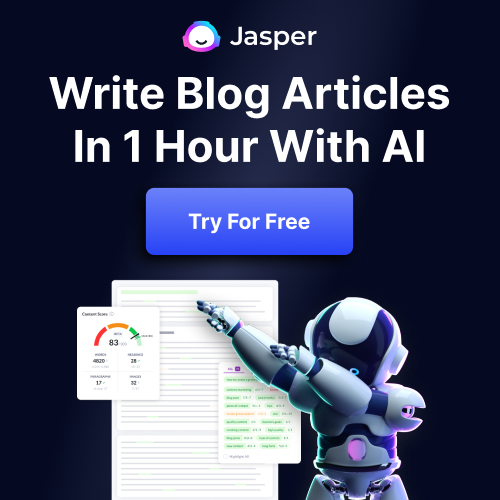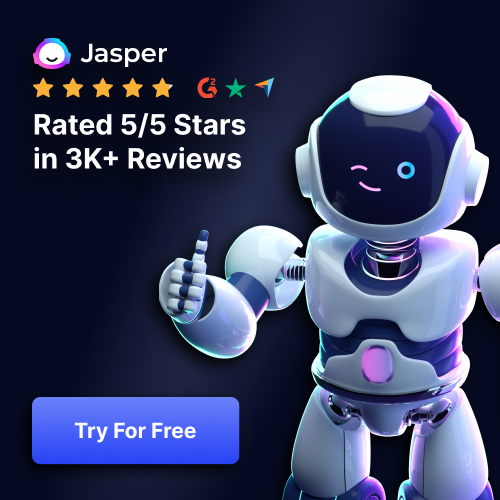GPT vs. Jasper AI: Content Creation Showdown

-
AI Driven Human-Like Content
-
Understanding the Technology Behind GPT and Jasper AI
-
Comparing the Features and Performance of GPT and Jasper AI
- Comparison Table
-
Applications and Use Cases for GPT and Jasper AI
-
AI Ethics, Safety, and Data Privacy
-
Computational Power and Hardware Requirements
-
Final Thoughts
Disclosure: Some of the links in this article may be affiliate links, which can provide compensation to me at no cost to you if you decide to purchase. This site is not intended to provide financial advice and is for entertainment only.
AI Driven Human-Like Content
In the rapidly evolving world of artificial intelligence (AI), two powerful giants have emerged as major players in the realm of content generation: Jasper AI and GPT (Generative Pre-trained Transformer). These AI-driven platforms employ natural language processing (NLP), machine learning (ML), and deep learning (DL) techniques to deliver high-quality, human-like content for a wide range of applications. In this comprehensive article, we'll delve into the features, performance, and potential use cases of each platform, enabling you to make an informed decision about which content creation tool is the best fit for your needs.
Understanding the Technology Behind GPT and Jasper AI
At the core of both GPT and Jasper AI lies the powerful transformer model, a type of neural network architecture that has revolutionized the field of NLP. GPT-4, the latest iteration in the GPT series, represents the cutting edge of AI research and has been developed by OpenAI, a leading AI research lab. In contrast, Jasper AI is a versatile chatbot and content creation platform that harnesses the power of GPT-based technology for an impressive array of applications.
Transformer models employ a combination of tokenization, training data, and fine-tuning to generate human-like text. These advanced AI systems are highly context-aware, capable of understanding and generating content based on a given topic, user input, or ongoing conversation. Additionally, transformer models are equipped with sentiment analysis functionality, allowing them to adapt to the tone and mood of a conversation or piece of content.
Beyond their core capabilities, GPT and Jasper AI utilize powerful techniques such as deep learning (DL) and neural networks, which enable them to learn and adapt over time. This results in increasingly sophisticated content generation, providing users with a valuable tool that can evolve alongside their needs.
Comparing the Features and Performance of GPT and Jasper AI
When it comes to content creation, both GPT and Jasper AI offer an extensive range of features, including text summarization, paraphrasing, content optimization, SEO, text expansion, grammar correction, style transfer, and more. However, there are some key differences between the two platforms that may influence your choice, depending on your specific requirements and preferences.
For instance, GPT is known for its impressive text generation capabilities, producing high-quality content with minimal user input. Jasper AI, on the other hand, is lauded for its conversational abilities, providing users with a more interactive and engaging experience when generating content. Moreover, Jasper AI boasts a user-friendly interface that makes it easy to navigate and utilize the platform's many features.
Comparison Table
Feature | GPT | |
|---|---|---|
Text Generation | ✓ | ✓ |
Context Awareness | ✓ | ✓ |
Conversational AI | ✓ | ✓ |
Sentiment Analysis | ✓ | ✓ |
AI Ethics and Safety | ✓ | ✓ |
Data Privacy | ✓ | ✓ |
Computational Power | ✓ | ✓ |
Multilingual Support | ✓ | |
User Interface | ✗ | ✓ |
As illustrated in the comparison table above, both GPT and Jasper AI offer an impressive array of features for content creation. While both platforms excel in text generation, context awareness, and conversational AI, Jasper AI has a slight edge in multilingual support and offers a more user-friendly interface, as evidenced by this article.
Applications and Use Cases for GPT and Jasper AI
Both GPT and Jasper AI have numerous applications and use cases across various industries, such as business, creativity, journalism, and more. For instance, these AI-powered tools can be employed for AI-assisted journalism, plagiarism detection, content optimization, and many other tasks. Some real-world examples of how companies are utilizing these technologies can be found in this article.
When it comes to keyword-rich content, both GPT and Jasper AI can help users optimize their content for search engine optimization (SEO) purposes. Additionally, both platforms can be used for grammar correction and style transfer, ensuring that the generated content is not only well-written but also engaging and appealing to readers.
Another area where GPT and Jasper AI can be highly beneficial is in human-AI interaction. By leveraging these AI-driven tools, users can save time and effort while generating high-quality, unique content tailored to their specific needs. This enables businesses and individuals to harness the power of AI for content creation in a more efficient and effective manner than ever before.
Furthermore, the applications of GPT and Jasper AI extend to areas such as text summarization, paraphrasing, and text expansion. These features allow users to quickly generate summaries of long articles or create unique variations of existing content, making it easier to repurpose material for various platforms and formats.
Both GPT and Jasper AI are also highly useful in content optimization, with the ability to analyze text and make suggestions for improvement. This can include optimizing content for SEO, ensuring that it is highly discoverable by search engines, and enhancing readability and user experience. This ultimately results in higher engagement rates, more conversions, and increased ROI for businesses that utilize these AI-powered content creation tools.
AI Ethics, Safety, and Data Privacy
With the increased adoption of AI technologies, concerns about AI ethics, safety, and data privacy have become more prevalent. Both GPT and Jasper AI place a strong emphasis on addressing these concerns by implementing responsible AI practices and robust data privacy measures.
As part of their commitment to AI ethics and safety, both platforms continuously refine their algorithms to minimize the risk of generating inappropriate, biased, or harmful content. They also invest in research and development to ensure that their AI models are transparent, accountable, and adhere to the highest ethical standards.
In terms of data privacy, both GPT and Jasper AI recognize the importance of protecting users' sensitive information. They employ strong encryption, secure data storage, and stringent access controls to safeguard user data, giving users peace of mind when using these AI-driven content creation tools.
Computational Power and Hardware Requirements
Advanced AI technologies like GPT and Jasper AI require significant computational power to perform their complex tasks. Both platforms leverage high-performance hardware, such as tensor processing units (TPU) and graphics processing units (GPU), to deliver fast and efficient content generation.
While the hardware requirements for GPT and Jasper AI may be more demanding than those for traditional content creation tools, the advantages offered by these AI-driven platforms far outweigh the associated costs. By harnessing the power of AI, users can generate high-quality, human-like content more quickly and easily than ever before, resulting in substantial time and cost savings.
Final Thoughts
Ultimately, both GPT and Jasper AI are powerful content creation tools that offer a wealth of features and applications. While there are some differences between the two platforms, they both excel in generating human-like content that is context-aware, engaging, and optimized for SEO.
Your choice between GPT and Jasper AI will likely depend on your specific needs and requirements, such as language support, user interface, or other features. Regardless of which platform you choose, these AI-driven tools have the potential to revolutionize the way we create content, making the process faster, easier, and more efficient than ever before.
For a more detailed comparison of GPT and Jasper AI, including their differences in multilingual support and other factors, be sure to check out the following articles: Jasper AI vs. Chat GPT: Which Platform Has Better Support for Multilingual? and Jasper AI vs. Chat GPT: Which AI Platform Is Better for Natural Language?.
As the field of AI continues to advance at a rapid pace, we can expect even more powerful and sophisticated content creation tools in the future. By staying informed about the latest developments and innovations in the world of AI, you can ensure that you are well-equipped to harness the power of these cutting-edge technologies for your own content generation needs.
-
AI Driven Human-Like Content
-
Understanding the Technology Behind GPT and Jasper AI
-
Comparing the Features and Performance of GPT and Jasper AI
- Comparison Table
-
Applications and Use Cases for GPT and Jasper AI
-
AI Ethics, Safety, and Data Privacy
-
Computational Power and Hardware Requirements
-
Final Thoughts
Disclosure: Some of the links in this article may be affiliate links, which can provide compensation to me at no cost to you if you decide to purchase. This site is not intended to provide financial advice and is for entertainment only.



